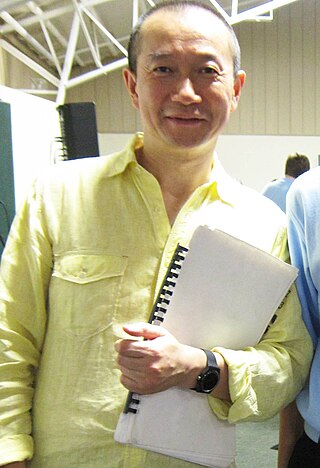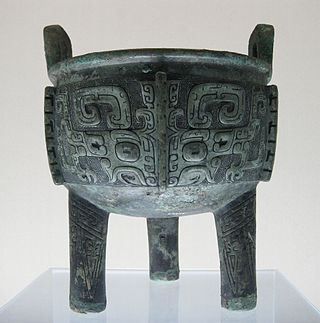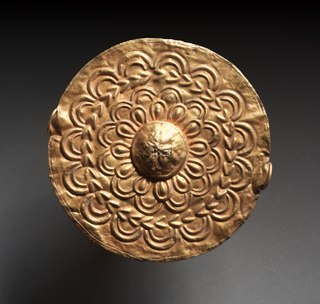
Tsuen Wan District is one of the 18 districts of Hong Kong. It is located in the New Territories and is served by the Tsuen Wan line of the MTR metro system. Its area is 60.7 km2. Its residents,who mostly live in Tsuen Wan Town,enjoy the highest income in the New Territories.

Tan Dun is a Chinese-born American composer and conductor. A leading figure of contemporary classical music,he draws from a variety of Western and Chinese influences,a dichotomy which has shaped much of his life and music. Having collaborated with leading orchestras around the world,Tan is the recipient of numerous awards,including a Grawemeyer Award for his opera Marco Polo (1996) and both an Academy Award and Grammy Award for his film score in Ang Lee's Crouching Tiger,Hidden Dragon (2000). His oeuvre as a whole includes operas,orchestral,vocal,chamber,solo and film scores,as well as genres that Tan terms "organic music" and "music ritual."

The zun or yi,used until the Northern Song (960–1126) is a type of Chinese ritual bronze or ceramic wine vessel with a round or square vase-like form,sometimes in the shape of an animal,first appearing in the Shang dynasty. Used in religious ceremonies to hold wine,the zun has a wide lip to facilitate pouring. Vessels have been found in the shape of a dragon,an ox,a goose,and more. One notable zun is the He zun from the Western Zhou.

Ding are prehistoric and ancient Chinese cauldrons standing upon legs with a lid and two fancy facing handles. They are one of the most important shapes used in Chinese ritual bronzes. They were made in two shapes:round vessels with three legs and rectangular ones with four,the latter often called fāng dǐng "square ding (方鼎. They were used for cooking,storage,and ritual offerings to the gods or to ancestors.

The traditions of Korean bladesmithing and swordsmanship have served a central place in the military history of Korea for thousands of years. Although typical Korean land battles have taken place in wide valleys and narrow mountain passes,which favor use of spears and bows,the sword found use as a secondary,close-quarters weapon,in addition to far more prominent role during sieges and ship-to-ship boarding actions. Higher quality,ceremonial swords were typically reserved for the officer corps as a symbol of authority with which to command the troops. Ceremonial swords are still granted to military officials by the civilian authority to this day.

A guang or gong is a particular shape used in Chinese art for vessels,originally made as Chinese ritual bronzes in the Shang dynasty,and sometimes later in Chinese porcelain. They are a type of ewer which was used for pouring rice wine at ritual banquets,and often deposited as grave goods in high-status burial. Examples of the shape may be described as ewers,ritual wine vessels,wine pourers and similar terms,though all of these terms are also used of a number of other shapes,especially the smaller tripod jue and the larger zun.

Bianzhong is an ancient Chinese musical instrument consisting of a set of bronze bells,played melodically. China is the earliest country to manufacture and use musical chimes. They are also called chime bells. These sets of chime bells were used as polyphonic musical instruments and some of these bells have been dated at between 2,000 to 3,600 years old. They were hung in a wooden frame and struck with a mallet. Using a wooden hammer and a rod to beat the bronze bell can make different pitch. Along with the stone chimes called bianqing,they were an important instrument in China's ritual and court music going back to ancient times.

Akan art is an art form that originated among the Akan people of Southern Ghana. Akan art is known for vibrant artistic traditions,including textiles,sculpture,Akan goldweights,as well as gold and silver jewelry. The Akan people are known for their strong connection between visual and verbal expressions and a distinctive blending of art and philosophy. Akan chiefs managed generations worth of gold regalia;finely crafted objects such as crowns,beads,bracelets,pectoral disks,swords and sword ornaments,linguist staffs,and umbrella finials.

The gourd mouth organ is a free reed mouth organ played across East and Southeast Asia. It consists of a gourd wind chest with several bamboo or bronze pipes inserted on top of it,the numbers of pipes differing from region to region.

From c. 1650 BC,elaborately decorated bronze vessels were deposited as grave goods in the tombs of royalty and nobility during the Chinese Bronze Age. Documented excavations have found over 200 pieces in a single royal tomb. They were produced for an individual or social group to use in making ritual offerings of food and drink to his or their ancestors and other deities or spirits. Such ceremonies generally took place in family temples or ceremonial halls over tombs. These ceremonies can be seen as ritual banquets in which both living and dead members of a family were supposed to participate. Details of these ritual ceremonies are preserved through early literary records. On the death of the owner of a ritual bronze,it would often be placed in his tomb,so that he could continue to pay his respects in the afterlife;other examples were cast specifically as grave goods. Indeed,many surviving examples have been excavated from graves.
Shandong Bin Ao Aircraft Industries Co.,Ltd. is located in the Dagao Town,Zhanhua County,Binzhou City,Shandong province,China.
Benoît Vermander,also known as Wei Mingde and Bendu,is a French Jesuit,sinologist,political scientist,and painter. He is currently professor of religious sciences at Fudan University,Shanghai,as well as academic director of the Xu-Ricci Dialogue Center within the University. He has been director of the Taipei Ricci Institute from 1996 to 2009 and the editor-in-chief of its electronic magazine erenlai. He is also consultor to the Pontifical Council for Inter-religious Dialogue. He holds a M.Phil in political science from Yale University,a doctorate in the same discipline from Institut d’Etudes Politiques de Paris,a Master of Sacred Theology from Fu Jen Catholic University (Taiwan) and a Doctorate in Sacred Theology from the Jesuit Faculties of Philosophy and Theology of Paris.

A hu is a type of wine vessel that has a pear-shaped cross-section. Its body swells and flares into a narrow neck,creating S-shaped profile. While it is similar to you vessel,hu usually has a longer body and neck. The shape of hu probably derives from its ceramic prototype prior to the Shang dynasty. They usually have handles on the top or rings attached to each side of neck. Many extant hu lack lids while those excavated in such tombs as Fu Hao's indicate that this type of vessel might be originally made with lids. Although it is more often to see hu having a circular body,there also appears hu in square and flat rectangular forms,called fang hu and bian huArchived 2015-09-23 at the Wayback Machine in Chinese. In addition,hu often came to be found in a pair or in a set together with other types of vessels. As wine had played an important part in the Shang ritual,the hu vessel might be placed in the grave of an ancestor as part of ritual in order to ensure a good relationship with ancestor's spirit.

A jia is a ritual vessel type found in both pottery and bronze forms;it was used to hold libations of wine for the veneration of ancestors. It was made either with four legs or in the form of a tripod and included two pillar-like protrusions on the rim that were possibly used to suspend the vessel over heat. The earliest evidence of the Jia vessel type appears during the Neolithic Period. It was a prominent form during the Shang and early Western Zhou dynasties,but had disappeared by the mid-Western Zhou.

The Tomb of Marquis Yi of Zeng is an archaeological site in Leigudun Community (擂鼓墩社區),Nanjiao Subdistrict (南郊街道),Zengdu District,Suizhou,Hubei,China,dated sometime after 433 BC. The tomb contained the remains of Marquis Yi of Zeng,and is one of a handful of ancient Chinese royal tombs to have been discovered intact and then excavated using modern archaeological methods. Zeng was a state during the Spring and Autumn period of China. The tomb was made around 433 BC,either at the end of the Spring and Autumn period or the start of the Warring States period. The tomb comes from the end of the thousand-year-long period of the burial of large sets of Chinese ritual bronzes in elite tombs,and is also unusual in containing large numbers of musical instruments,including the great set of bells for which it is most famous.

A dui is a type of Chinese ritual bronze vessel used in the late Zhou dynasty and the Warring States period of ancient China. It was a food container used as a ritual vessel. Most dui consist of two bowls supported on three legs.

A gu is a type of ancient Chinese ritual bronze vessel from the Shang and Zhou dynasties. It was used to drink wine or to offer ritual libations.
French May Arts Festival is an annual arts festival organized by the Association Culturelle France - Hong Kong Limited to promote French art and culture. Events include visual arts,operas,classical and contemporary dance,music and theatre,circus as well as cinema.

Chinese patchwork is a traditional form of Chinese needlework which has been widely circulated in Chinese folk arts. In China,patchwork has been used for millennia.
Chou Ching-hui is a Taiwanese artist and photographer.
















